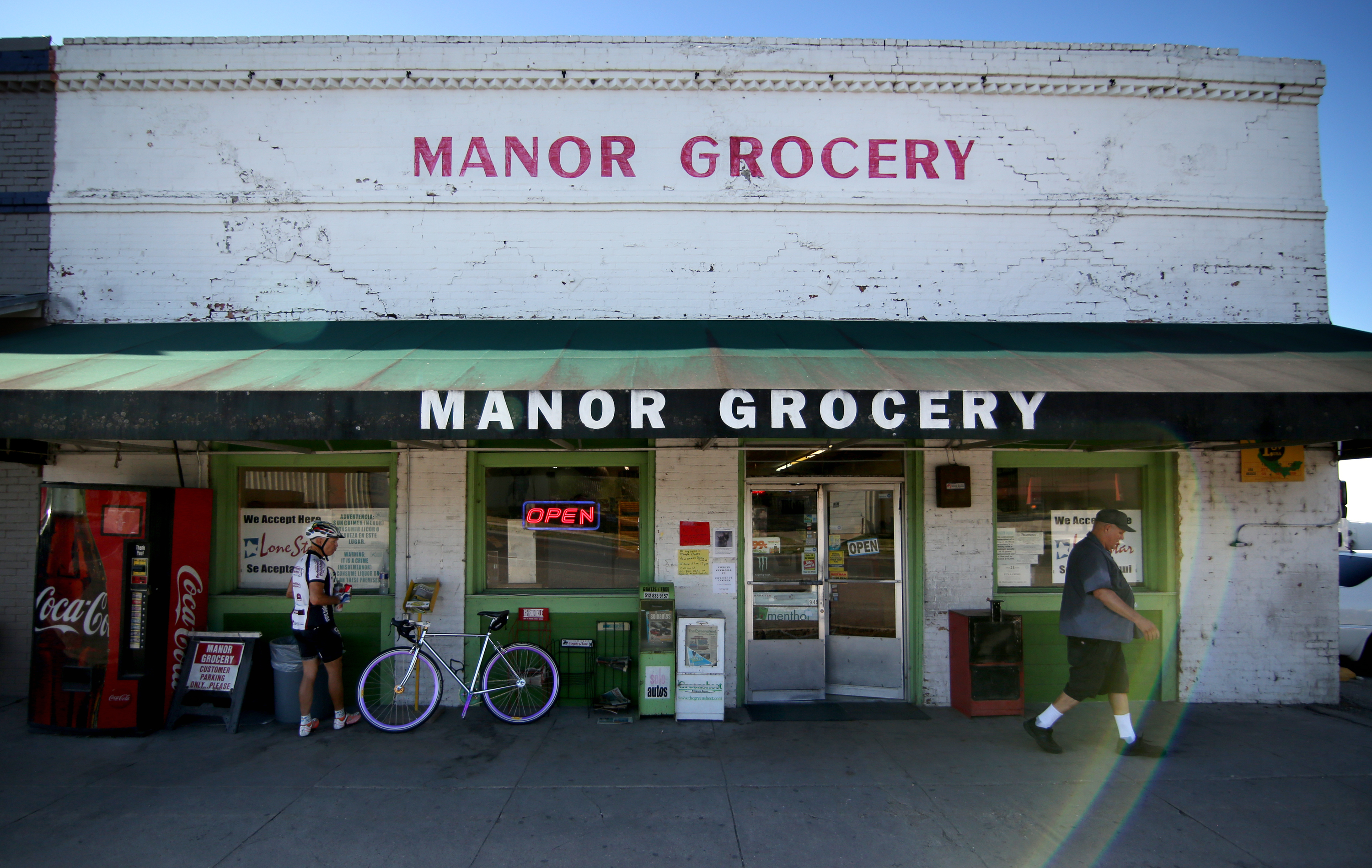What happens when Walmart moves to town?
by Audrey McGlinchy, KUT and Austin Monitor
Sam Rahaman exits the Walmart in Manor cradling three-dozen eggs he bought for roughly $8. A middle-aged father of four originally from Nigeria, Rahaman is starting his sixth year as a Manor resident.
“Before, it wasn’t like this,” he said, nodding his head toward the Walmart behind him. “But now the whole place is growing, and we have this Walmart and the other one that is in Elgin.”
The mega-chain held its grand opening in Manor in February 2014. And it’s hard to find someone who won’t expound on what it means for this town of roughly 7,000 people.
Nayeli Vences is a sophomore at the University of Texas at San Antonio. She said she and her parents moved to Manor when she was in the sixth grade.
“Every time (my friends) ask me, ‘Where are you from?’ I just tell them I’m from Austin, but I’m actually really from Manor. Because it’s on the map, but nobody knows about it,” she said, standing against her car as her 5-year-old sister fiddled with the radio dial. “It’s definitely changed a lot – we just got a Walmart.”
In July 2012, Walmart announced it would build between 275 and 300 new stores throughout towns in the U.S. thought to be food deserts – places with economic and physical barriers to fresh, healthy food. The plan was a partnership with First Lady Michelle Obama’s campaign against childhood obesity.
A blog post on the company’s website read, “From the beginning we’ve always said that a customer shouldn’t have to choose between a food that is healthier for them and a food they can afford. Families should have reasonable access to a store that provides healthy choices and helps that family live better.”
Walmart spokesperson Anne Hatfield said the company researches a town in order to scale its need for a shop. “We will locate stores based on the need,” she said. “Where there is residential growth, you will then find the increasing need for retail services.”
According to the U.S. Department of Agriculture, Manor is not a food desert. More precisely, it was not a food desert in 2010, even before Walmart’s arrival. The list of grocery stores the federal agency uses to determine if residents live too far from available food is five years old – predating the new store.
“We’ve always had little markets in town, and that’s great because you go in and you know the people there, but it’s limited the kind of service that they can provide.” Manor City Council member Rebecca Davies
In fact, looking at the USDA’s food desert map, Manor appears to be an inlet of food access prosperity relative to much of East Austin, which is shrouded in green, the color that marks an area as a food desert. The green dissipates within Manor’s borders.
But this can be misleading. Dr. Susan Millea with Children’s Optimal Health, an organization that tracks health service needs throughout central Texas, said problems arise when low- to moderate-income families court cheaper housing outside of Austin. It’s a trend Austin’s City Demographer Ryan Robinson has pointed out. Millea said there’s then a snowball effect — families who move outside of Austin likely still commute there for work, and this travel stresses the family’s budget.
“It also has a huge impact in terms of time, for the amount of time they’re spending stuck in traffic,” she said. “That, in turn, has an impact on their time availability to prepare healthy foods at home.” Millea said families then resort to “convenient” eating, or fast-food options.
For some Manor residents, cost remains a barrier for some. According to U.S. Census data, roughly 18 percent of Manor residents qualify for SNAP benefits, or food stamps.
Manor City Council Member Rebecca Davies said Walmart’s presence in town changed the way locals could shop for groceries. She sat in a local restaurant – Big Country Grill, along Manor’s main street – finishing her late lunch of a salad.
“Walmart provides more of a, not really traditional, but more of a one-stop shop because you can go and get everything on your list,” Davies said. “We’ve always had little markets in town, and that’s great because you go in and you know the people there, but it’s limited the kind of service that they can provide.”
Across the street is Manor Grocery, the local grocery store for more than 25 years. He doesn’t come to the store every day, but when he does, owner Hassan Moein – everyone calls him “Mr. Joe” – stands outside with a small cup of coffee poured from the store’s brew. On a recent Wednesday morning, he helped a woman open a gas can she had bought to fill her car, after the tank had run out down the street.
Enlarge

Jorge Sanhueza-Lyon
Manor Grocery is a cross between a convenience store and a place to grab a few staples. On a recent Friday morning, shelves had been stocked with Hamburger Helper and several flavors of pasta sauce. On a shelf advertising large tomatoes for sale – $1.59 a pound – a lone bottle of lemonade sat. No tomatoes.
That’s not to say residents don’t have their complaints about Walmart’s shelves. Ana Cortez, who owns the local coffee shop, Zetroc Kaffee, said she often sees old produce there. “It seems like we get stocked at the end, and we get the older produce, so it goes bad really quick,” she said. “We wish it was an HEB.”
Hatfield, Walmart’s spokesperson, said local managers are open to feedback. “If ever we are not serving our customers to meet their needs, then we absolutely want to hear about it,” she said.
After 27 years of owning the place, just four months ago Mr. Joe decided to bring on a partner to help – most of this, he said, is because his health is failing. But business is also slowing since Walmart moved in. Mr. Joe said he relies on the loyalty of his customers, of which more than 100 have open accounts at his store.
Just down the road, Shannon Jones, director of the Austin/Travis County Health and Human Services Department, addressed a roomful of people in a Manor ISD building. He told them about a health assessment, initiated in 2012, in which staff from his department met with communities throughout Travis County. In Manor, he said, staff identified several priorities: combating childhood obesity, increasing access to healthy foods and building more one-stop shops, like Walmart.
“Having lived in Manor, I was one of those who was extremely happy to see we got a Walmart,” said Jones. “Hopefully we’ll get an HEB one day. Hopefully we’ll get some other things.”
When Jones stepped down from the podium, the group seated at round tables broke up into small conversations. They’d been told to make a list of community resources and needs. Walmart made it to the top of that resources list. On the list of needs, someone mentioned a community garden; another suggested building partnerships between Manor ISD and farms to get fresh food into school cafeterias. Several people talked about creating incentives so that other grocery stores would make the trek out to Manor.
Back at Mr. Joe’s Manor Grocery, customers who came in before 8 a.m. said they hoped Walmart was just the start.
Mr. Joe pointed to his store. “It used to be that’s the only store in Manor,” he said. “And now we see a lot of stores, which is growing Manor.”
The stores are growing Manor. Council Member Davies agreed.
“We’ve found a lot more businesses coming in,” Davies said, adding that Starbucks will soon open in Manor. “A lot of food businesses are actually coming in. Everybody’s always asking when we’re going to get other grocery stores in the area. We would love to see more grocery stores in the area, but of course we can only ask – we can’t make them build.”
Providing food access for all
by Allison Sandza and Blair Waltman-Alexin, KLRU
The Bannockburn Baptist Church in Manor opened a food pantry a few years ago. In the last year and a half, they have seen demand spike. Once a week they offer free vegetables, meats, cereal – you name it – free of charge to anyone. Clients get to stroll the aisles and pick out what they like. “All it takes is to have a hungry belly and come in and fill out a couple forms, and you’re good,” Pastor Luis Holguin says.

